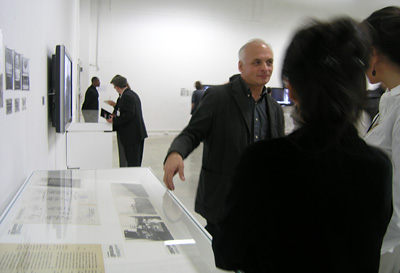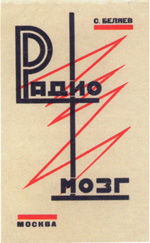Experiments in sound and electronic music in early 20 th -century Russia
 Interview with A.Smirnov about the Sound_in_Z exhibition (in Russian) Interview with A.Smirnov about the Sound_in_Z exhibition (in Russian)
 Review from the Wire Magazine, February, 2009 (pdf 1.2 mb) Review from the Wire Magazine, February, 2009 (pdf 1.2 mb)
 More info More info
We are very sorry: since 24 February 2022 the letter Z became a symbol of Russian fascism and national disgrace...
 Sound in Z is an exhibition of audio, visual, textual and documentation material that offers an introduction to experiments in sound and electronic music in early 20-th century Russia. The exhibition revolves around the archives of the Theremin Centre, Moscow – an institution whose history is inextricably interwoven with the development of music and audio technology in Russia during the 20 th Century, and which is now a part of the Moscow State Conservatory.
 The exhibition is curated by Andrey Smirnov and Matt Price with assistance from Christina Steinbrecher in the frame of the project FROM ONE REVOLUTION TO ANOTHER - Carte blanche to Jeremy Deller at Palais de Tokyo, Paris, (20.09.08 - 22.01.09). The exhibition is curated by Andrey Smirnov and Matt Price with assistance from Christina Steinbrecher in the frame of the project FROM ONE REVOLUTION TO ANOTHER - Carte blanche to Jeremy Deller at Palais de Tokyo, Paris, (20.09.08 - 22.01.09).
The exhibition has been developed as a part of Generation Z, an ongoing project by Andrei Smirnov and Lubov Pchelkina that is attempting to restore the censored history and culture of the artistic Utopia of the 1910s and 1920s that was destroyed through its collision with the totalitarian state of the 1930s.
 The title of the exhibition takes its name from the letter Z, which is in many ways emblematic of the period.
Z is for zigzag, the spark; it is the symbol of energy, of radio transmissions and communications, of electrical charges and of lightning. ‘From a spark the flame will flare up' – this popular expression of the time offers a sense of the spirit characteristic of it. Z, the spark, is a letter that represents the horizontal networks synonymous with the period, and simultaneously the counter currents of the vertical forces and pressures that stifled its development. The title of the exhibition takes its name from the letter Z, which is in many ways emblematic of the period.
Z is for zigzag, the spark; it is the symbol of energy, of radio transmissions and communications, of electrical charges and of lightning. ‘From a spark the flame will flare up' – this popular expression of the time offers a sense of the spirit characteristic of it. Z, the spark, is a letter that represents the horizontal networks synonymous with the period, and simultaneously the counter currents of the vertical forces and pressures that stifled its development.
Sound in Z offers an introduction to some of the key figures of the period and their areas of research. Most of the featured documentation, sound and footage has not previously been made available in the West and tantalizingly offers just a taste of the material from the period that remains to be explored.
 While some revolutionary ideas were little more than science fiction at the time, many projects and proposals were more immediately viable or were actively seeking to develop the technology necessary to deliver them. In 1921 the State Institute for Musical Science (GIMN) was founded with the intention of uniting musical researchers and inventors from across Russia. Working on the draft program of GIMN, composer Arseny Avraamov (1886-1944) proposed a project named ‘Topographical Acoustics.' He suggested building powerful electro-acoustic systems that could be installed on aeroplanes, from which vast areas of land could be covered with sound. Some of his projects explored new genres of music devised specifically for urban contexts and presented around the built environment. One such project by Avraamov (inspired by the poetry of Alexei Gastev) that is referenced in the Sound in Z exhibition is the Symphony of Sirens – a large-scale open-air performance of factory whistles, foghorns, artillery fire and all manner of machine-made noises first staged in the port town of Baku in 1922 in celebration of the fifth anniversary of the revolution. While some revolutionary ideas were little more than science fiction at the time, many projects and proposals were more immediately viable or were actively seeking to develop the technology necessary to deliver them. In 1921 the State Institute for Musical Science (GIMN) was founded with the intention of uniting musical researchers and inventors from across Russia. Working on the draft program of GIMN, composer Arseny Avraamov (1886-1944) proposed a project named ‘Topographical Acoustics.' He suggested building powerful electro-acoustic systems that could be installed on aeroplanes, from which vast areas of land could be covered with sound. Some of his projects explored new genres of music devised specifically for urban contexts and presented around the built environment. One such project by Avraamov (inspired by the poetry of Alexei Gastev) that is referenced in the Sound in Z exhibition is the Symphony of Sirens – a large-scale open-air performance of factory whistles, foghorns, artillery fire and all manner of machine-made noises first staged in the port town of Baku in 1922 in celebration of the fifth anniversary of the revolution.
 The late 1920s was also the period in which sound was being developed to accompany films and animations in Russia and during the work on the first Soviet sound-on-film movie “ Piatiletka. The Plan of the Great Works” in October 1929 the idea of artificially synthesized sound tracks was formulated. It was Avraamov who completed the first artificial drawn sound tracks in 1930 and b y 1 936 there were four main trends of Graphical Sound in Soviet Russia: hand-drawn Ornamental Sound (Avraamov, early Boris Yankovsky); hand-made Paper Sound (Nikolai Voinov); Variophone or automated Paper Sound (Evgeny Sholpo, Georgy Rimsky-Korsakov); and the spectral analysis, decomposition and re-synthesis technique (Boris Yankovsky). Yankovsky's idea was related to the separation of the spectral content of sound and its formants, resembling the popular recent computer music techniques of cross synthesis and the phase vocoder. It was certainly one of the most radical, paradigm-shifting propositions of the mid 1930s. Researchers involved in Graphical Sound had to overcome enormous technical and theoretical (as well as more mundane) difficulties during its short existence. The results of their work were surprising and unexpected, and ahead of the group's time by decades. However, collision with the state was fatal. In less than ten years, all of their work had ended and was almost instantly forgotten. The late 1920s was also the period in which sound was being developed to accompany films and animations in Russia and during the work on the first Soviet sound-on-film movie “ Piatiletka. The Plan of the Great Works” in October 1929 the idea of artificially synthesized sound tracks was formulated. It was Avraamov who completed the first artificial drawn sound tracks in 1930 and b y 1 936 there were four main trends of Graphical Sound in Soviet Russia: hand-drawn Ornamental Sound (Avraamov, early Boris Yankovsky); hand-made Paper Sound (Nikolai Voinov); Variophone or automated Paper Sound (Evgeny Sholpo, Georgy Rimsky-Korsakov); and the spectral analysis, decomposition and re-synthesis technique (Boris Yankovsky). Yankovsky's idea was related to the separation of the spectral content of sound and its formants, resembling the popular recent computer music techniques of cross synthesis and the phase vocoder. It was certainly one of the most radical, paradigm-shifting propositions of the mid 1930s. Researchers involved in Graphical Sound had to overcome enormous technical and theoretical (as well as more mundane) difficulties during its short existence. The results of their work were surprising and unexpected, and ahead of the group's time by decades. However, collision with the state was fatal. In less than ten years, all of their work had ended and was almost instantly forgotten.

This was true not just for the group working on artificial soundtracks but also for many other areas of experimentation and advancement in science and culture during the 1930s. By the late 1930s, the cultural and intellectual elite of the previous two decades had effectively been wiped out or rendered powerless.
Andrei Smirnov and Lubov Pchelkina, Moscow, 2008
Abstracts of the articles in PALAIS / Quarterly magazine. 07 autumn / fall 2008, pp. 66-77, 87
Edited by Matt Price
More info
|

 The exhibition is curated by Andrey Smirnov and Matt Price with assistance from Christina Steinbrecher in the frame of the project
The exhibition is curated by Andrey Smirnov and Matt Price with assistance from Christina Steinbrecher in the frame of the project  The title of the exhibition takes its name from the letter Z, which is in many ways emblematic of the period.
Z is for zigzag, the spark; it is the symbol of energy, of radio transmissions and communications, of electrical charges and of lightning. ‘From a spark the flame will flare up' – this popular expression of the time offers a sense of the spirit characteristic of it. Z, the spark, is a letter that represents the horizontal networks synonymous with the period, and simultaneously the counter currents of the vertical forces and pressures that stifled its development.
The title of the exhibition takes its name from the letter Z, which is in many ways emblematic of the period.
Z is for zigzag, the spark; it is the symbol of energy, of radio transmissions and communications, of electrical charges and of lightning. ‘From a spark the flame will flare up' – this popular expression of the time offers a sense of the spirit characteristic of it. Z, the spark, is a letter that represents the horizontal networks synonymous with the period, and simultaneously the counter currents of the vertical forces and pressures that stifled its development.  While some revolutionary ideas were little more than science fiction at the time, many projects and proposals were more immediately viable or were actively seeking to develop the technology necessary to deliver them. In 1921 the State Institute for Musical Science (GIMN) was founded with the intention of uniting musical researchers and inventors from across Russia. Working on the draft program of GIMN, composer Arseny Avraamov (1886-1944) proposed a project named ‘Topographical Acoustics.' He suggested building powerful electro-acoustic systems that could be installed on aeroplanes, from which vast areas of land could be covered with sound. Some of his projects explored new genres of music devised specifically for urban contexts and presented around the built environment. One such project by Avraamov (inspired by the poetry of Alexei Gastev) that is referenced in the Sound in Z exhibition is the Symphony of Sirens – a large-scale open-air performance of factory whistles, foghorns, artillery fire and all manner of machine-made noises first staged in the port town of Baku in 1922 in celebration of the fifth anniversary of the revolution.
While some revolutionary ideas were little more than science fiction at the time, many projects and proposals were more immediately viable or were actively seeking to develop the technology necessary to deliver them. In 1921 the State Institute for Musical Science (GIMN) was founded with the intention of uniting musical researchers and inventors from across Russia. Working on the draft program of GIMN, composer Arseny Avraamov (1886-1944) proposed a project named ‘Topographical Acoustics.' He suggested building powerful electro-acoustic systems that could be installed on aeroplanes, from which vast areas of land could be covered with sound. Some of his projects explored new genres of music devised specifically for urban contexts and presented around the built environment. One such project by Avraamov (inspired by the poetry of Alexei Gastev) that is referenced in the Sound in Z exhibition is the Symphony of Sirens – a large-scale open-air performance of factory whistles, foghorns, artillery fire and all manner of machine-made noises first staged in the port town of Baku in 1922 in celebration of the fifth anniversary of the revolution.  The late 1920s was also the period in which sound was being developed to accompany films and animations in Russia and during the work on the first Soviet sound-on-film movie “ Piatiletka. The Plan of the Great Works” in October 1929 the idea of artificially synthesized sound tracks was formulated. It was Avraamov who completed the first artificial drawn sound tracks in 1930 and b y 1 936 there were four main trends of Graphical Sound in Soviet Russia: hand-drawn Ornamental Sound (Avraamov, early Boris Yankovsky); hand-made Paper Sound (Nikolai Voinov); Variophone or automated Paper Sound (Evgeny Sholpo, Georgy Rimsky-Korsakov); and the spectral analysis, decomposition and re-synthesis technique (Boris Yankovsky). Yankovsky's idea was related to the separation of the spectral content of sound and its formants, resembling the popular recent computer music techniques of cross synthesis and the phase vocoder. It was certainly one of the most radical, paradigm-shifting propositions of the mid 1930s. Researchers involved in Graphical Sound had to overcome enormous technical and theoretical (as well as more mundane) difficulties during its short existence. The results of their work were surprising and unexpected, and ahead of the group's time by decades. However, collision with the state was fatal. In less than ten years, all of their work had ended and was almost instantly forgotten.
The late 1920s was also the period in which sound was being developed to accompany films and animations in Russia and during the work on the first Soviet sound-on-film movie “ Piatiletka. The Plan of the Great Works” in October 1929 the idea of artificially synthesized sound tracks was formulated. It was Avraamov who completed the first artificial drawn sound tracks in 1930 and b y 1 936 there were four main trends of Graphical Sound in Soviet Russia: hand-drawn Ornamental Sound (Avraamov, early Boris Yankovsky); hand-made Paper Sound (Nikolai Voinov); Variophone or automated Paper Sound (Evgeny Sholpo, Georgy Rimsky-Korsakov); and the spectral analysis, decomposition and re-synthesis technique (Boris Yankovsky). Yankovsky's idea was related to the separation of the spectral content of sound and its formants, resembling the popular recent computer music techniques of cross synthesis and the phase vocoder. It was certainly one of the most radical, paradigm-shifting propositions of the mid 1930s. Researchers involved in Graphical Sound had to overcome enormous technical and theoretical (as well as more mundane) difficulties during its short existence. The results of their work were surprising and unexpected, and ahead of the group's time by decades. However, collision with the state was fatal. In less than ten years, all of their work had ended and was almost instantly forgotten. 